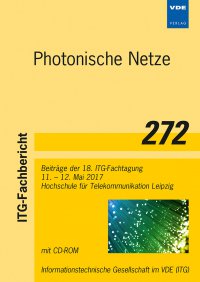Towards Information-Theoretic Security in Optical Networks
Conference: Photonische Netze - 18. ITG-Fachtagung
05/11/2017 - 05/12/2017 at Leipzig, Deutschland
Proceedings: Photonische Netze
Pages: 7Language: englishTyp: PDF
Personal VDE Members are entitled to a 10% discount on this title
Authors:
Forutan, Vahid; Fischer, Robert F. H. (Institute of Communications Engineering, Ulm University, Ulm, Germany)
Elschner, Robert; Schmidt-Langhorst, Carsten; Schubert, Colja (Fraunhofer Institute for Telecommunications, Heinrich-Hertz-Institute, Berlin, Germany)
Abstract:
In fiber-optic communication networks, research on data security at lower layers of the protocol stack and in particular at the physical layer by means of information-theoretic concepts is only in the beginning. Nevertheless, it has recently attracted quite some attention as it holds the promise of providing unconditional, perfect security without the need for secret key exchanges. In this paper, we analyze some important constraints that such concepts put on a potential implementation of physical-layer security. We review the fundamentals of physical-layer security on the basis of the commonly used AWGN wiretap channel model. For such channel model we summarize the security metrics which are typically used in information theory and in particular recall that, for secure communication over the AWGN channel, the legitimate receiver needs an SNR advantage over the eavesdropper. Next, we relate the information theoretic metrics to physically measurable quantities in optical communications engineering, namely optical signal-to-noise ratio (OSNR) and bit-error ratio (BER), and translate the information-theoretic wiretap scenario to a simple real-world point-to-point optical transmission link in which part of the light is wiretapped using a bend coupler. We investigate the achievable OSNR advantage under realistic assumptions for fiber loss, tap ratio, and noise budget and find that secure transmission is limited to a distance of a few tens of kilometers in this case. The maximum secure transmission distance decreases with an increasing tap ratio chosen by the eavesdropper. This can be only counteracted by monitoring the link loss towards the legitimate receiver which would force the eavesdropper to choose small tap ratios in order to remain undetected. In an outlook towards further research directions we identify information-theoretic approaches which could potentially allow to realize physical-layer security in more generalized scenarios or over longer distances.


